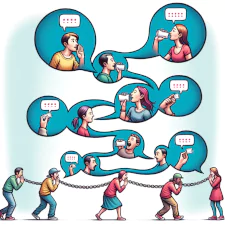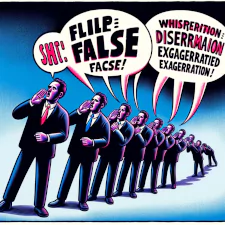Fighting propaganda and disinformation is crucial for several reasons: it preserves the integrity of democratic processes. Ensuring informed decision-making in protecting public health by countering false information about diseases and vaccines. Maintaining national security by preventing the spread of harmful narratives that could undermine societal trust and cohesion. Addressing these challenges helps maintain a well-informed public, essential for the effective functioning of democracies and the protection of individual freedoms.
Key Takeaways:
- Combating political propaganda and disinformation is vital for preserving democratic societies by promoting media literacy and critical thinking among the public.
- Educational initiatives, technological solutions, and regulatory measures are essential strategies to counteract misinformation and uphold journalistic integrity.
- Personal responsibility in verifying information and diverse community actions play crucial roles in fostering a well-informed society and combating the spread of false narratives.
What is Propaganda?
Propaganda is the systematic effort to manipulate public perception or influence opinion towards a particular agenda or ideology. It employs various techniques and media to convey messages that may exaggerate, distort, or omit information to provoke emotional rather than rational responses.
Propaganda is used by governments, organizations, and individuals, aiming to shape public opinion, control political views, and sometimes to incite action in line with the propagandist’s objectives.
What is Disinformation?
Disinformation is the deliberate creation and dissemination of false information with the intent to deceive or mislead.
What is Misinformation?
Misinformation refers to false or inaccurate information that is spread, either intentionally or unintentionally, often misleading or deceiving individuals. It can manifest in various forms, including rumors, conspiracy theories, manipulated content, and distorted facts. Misinformation can have significant consequences, undermining public trust, influencing decision-making, and exacerbating societal divisions.
Table of Contents
- Propaganda and Disinformation
- Propaganda 101
- Propaganda strategy
- Combating Propaganda with Critical Thinking and Education
- Understanding Disinformation
- United States Department of Homeland Security (DHS)
- Disinformation Quotes
- "The best way to control the opposition is to lead it ourselves."
- "We'll know our disinformation program is complete when everything the American public believes is false."
- "Falsehood flies, and truth comes limping after it."
- "Disinformation is a weapon of mass destruction."
- “The greatest enemy of knowledge is not ignorance, it is the illusion of knowledge.”
- "In an age of universal deceit, telling the truth is a revolutionary act."
- “Misinformation can be harmful, but disinformation meant to deceive, is a weapon of corruption.”
- Disinformation Impact on Society and Politics
- Strategies to Counter Disinformation
- The Role of Technology in Combating Disinformation
- Importance of Combating Political Propaganda and Disinformation:
Propaganda and Disinformation
In an era where information is as influential as it is accessible, the proliferation of political propaganda and disinformation has become a central challenge to the integrity of public discourse and democratic processes. Political propaganda, defined by its intent to sway public opinion through biased, misleading, or manipulative tactics, often intertwines with disinformation – deliberately false information spread to deceive.
This complex web not only distorts the public’s understanding of critical issues but also undermines trust in institutions, media, and the democratic framework itself. Addressing this dual challenge requires a nuanced understanding of their sources, motives, and impacts, as well as a multifaceted strategy encompassing education, media integrity, regulatory frameworks, and public engagement.
Propaganda 101

This battle lies in fostering critical thinking and media literacy. By educating individuals to discern and scrutinize information, societies can cultivate a more resilient public, less susceptible to the allure of false narratives.
This educational approach extends beyond traditional classrooms, encompassing digital literacy programs that empower people to navigate and critically assess the vast information landscape of the internet and social media.
Parallel to this, supporting independent media and fact-checking organizations provides an essential counterbalance to biased reporting and outright falsehoods. These organizations serve as vital watchdogs, offering objective analysis and debunking misinformation and propaganda. This dual approach – bolstering critical thinking and championing independent media – forms a cornerstone in safeguarding societies against the corrosive effects of propaganda and disinformation.
Propaganda WWI Posters

True Sons of Freedom . , 1918. Chicago: Chas. Gustrine. Photograph. https://www.loc.gov/item/93503146/.
During World War I, propaganda played a significant role in shaping public opinion and military participation, including that of African Americans. The United States government and various organizations utilized propaganda to encourage African American enlistment, portraying the war as a fight for democracy and an opportunity to earn equal rights and respect.
Posters, films, and speeches highlighted themes of patriotism and the chance for African Americans to prove their loyalty and valor on the battlefield. This narrative promised a redefinition of their social status in America, appealing to their desire for equality and justice.
However, the reality often contrasted sharply with these promises, as African American soldiers faced segregation, discrimination, and limited roles in the military. The propaganda of African Americans fighting in WWI was a complex mix of genuine patriotism and a strategic appeal to a marginalized community, offering hopes of social change that were only partially realized in the war’s aftermath.
Propaganda Logical Fallacies
Propaganda logical fallacies refer to misleading or deceptive arguments used within propaganda to manipulate public opinion or promote certain ideas, often by exploiting emotions, biases, or ignorance. These fallacies are flawed reasoning tactics that divert attention from the weakness of an argument by appealing to emotions, authority, or fear, rather than relying on logical, factual evidence. Common examples include:
- Ad Hominem Fallacy: Attacking the character or motives of a person making an argument, rather than addressing the argument itself.
- Appeal to Fear: Using fear to persuade the audience to agree with the propagandist, often by exaggerating potential dangers.
- Straw Man Fallacy: Misrepresenting or oversimplifying someone’s argument to make it easier to attack or refute.
- Bandwagon Appeal: Suggesting that something is true or right because it is popular or because “everyone is doing it.”
- False Dilemma/False Dichotomy: Presenting only two choices, when in fact more options exist, often framing one option as the only positive or reasonable choice.
- Red Herring: Introducing irrelevant material to the argument to distract and lead toward a different conclusion.
- Slippery Slope: Arguing that a relatively small first step inevitably leads to a chain of related negative events.
These fallacies are often used in political and advertising campaigns to sway public opinion without engaging in honest or logical debate.
Propaganda Loaded Words
Propaganda loaded words are emotionally charged terms used to evoke strong feelings in the audience, influencing their perception and reaction without the need for detailed argument or evidence.
These words carry connotations that go beyond their literal meanings and are strategically employed in propaganda to elicit a desired response, often bypassing rational analysis. Loaded words can be positive or negative:
Positive Loaded Words:
These are used to create a favorable impression of a subject, idea, or person. They might include terms like
- Freedom
- Honor
- Progress
- Courage
- Patriotism
Such words aim to invoke feelings of pride, loyalty, and admiration.
Negative Loaded Words:
These are used to provoke a negative or hostile reaction towards a subject, idea, or person. Examples include words like
- Tyranny
- Radical
- Traitor
- Corruption
- Disaster
They are designed to stir up fear, anger, or disgust.
The use of loaded words is a powerful tool in shaping public opinion and is commonly found in political speeches, advertising, news media, and persuasive writing. The emotional response these words trigger can overshadow rational judgment, leading to biased or simplistic viewpoints.
Propaganda strategy
Encompasses a range of tactics and techniques designed to influence public opinion and behavior, often used by governments, organizations, and media entities. Central to this strategy is the selective use of information, both true and false, to shape perceptions and manipulate emotions.
This can involve the exaggeration of facts, the omission of inconvenient details, or the outright fabrication of data. Propaganda strategies often employ techniques such as:
- Appealing to fear
- Using loaded language
- Creating a common enemy
- Invoking national pride
- Unify and mobilize the populace.
Repetition is another key element, where messages are continuously broadcasted to reinforce the desired belief or behavior.
The ultimate goal is to create a controlled narrative that aligns public perception with the propagandist’s objectives, whether it be for political gain, societal control, or commercial profit. In modern times, social media and digital platforms have amplified the reach and sophistication of propaganda strategies, making them more pervasive and harder to discern.
Combating Propaganda with Critical Thinking and Education
One of the most effective ways to combat political propaganda and disinformation is through the promotion of critical thinking and education. Educating the public about the tactics used in propaganda, such as emotional appeals, misinformation, and biased reporting, can help people recognize when they are being manipulated.
Schools and educational institutions play a pivotal role by integrating media literacy into their curriculum. This includes teaching students how to analyze and interpret media messages, check for credibility and factuality, and understand the difference between opinion and evidence-based reporting. Encouraging a culture of questioning and skepticism can be a powerful antidote to the uncritical acceptance of propagandist messages.
Educational Initiatives:
- Media Literacy: Educate people, especially students, on how to critically analyze media messages, discern credible sources, and identify propaganda techniques.
- Promoting Critical Thinking: Foster a culture of critical thinking and open debate in educational institutions to encourage discernment and skepticism towards unverified information.
Technological Solutions Fact Checking Propaganda:
- Fact-Checking Tools: Support the development and usage of tools that help in instant fact-checking of news and information.
- Algorithm Accountability: Encourage social media platforms to be transparent and responsible in how their algorithms promote content, ensuring they don’t amplify propaganda.
Regulatory Measures to Fight Propaganda:
- Transparency in Political Advertising: Implement regulations that require transparency in the funding and sources of political advertisements.
- Accountability for Misinformation: Consider regulations that hold individuals or entities accountable for spreading false or misleading political information.
Propaganda and Journalistic Integrity:
- Supporting Independent Journalism: Encourage and support journalistic practices that prioritize truth, objectivity, and thorough investigation.
- Ethical Standards: Promote adherence to ethical standards and practices in journalism to enhance credibility and trustworthiness.
Public Awareness and Engagement:
- Public Awareness Campaigns: Run campaigns to educate the public about the prevalence and dangers of political propaganda.
- Encouraging Public Discourse: Promote spaces for healthy public discourse and debate where various perspectives are considered.
Personal Responsibility:
- Diversifying Information Sources: Encourage individuals to seek information from a variety of sources to have a more rounded understanding of issues.
- Verification Before Sharing: Promote the habit of verifying information before sharing it on social media or other platforms.
Community and Societal Actions:
- Community Discussions: Facilitate community discussions and forums where people can engage in meaningful conversations about political issues.
- Promoting Civic Education: Encourage a strong foundation of civic education to understand the political process and the role of propaganda.
Understanding Disinformation
Disinformation refers to false information spread deliberately to deceive.

Misinformation may be spread without malicious intent.
Disinformation is created and disseminated to manipulate public opinion or obscure the truth. In the digital age, the rapid spread of disinformation through social media and other online platforms has become a significant concern.
It can influence public discourse, affect political processes, and even impact social harmony. Recognizing the sources, motives, and methods of disinformation is crucial in understanding its impact on society and in devising strategies to combat it.
United States Department of Homeland Security (DHS)
Disinformation Governance Board
it is an entity within the United States Department of Homeland Security (DHS). The board was intended to coordinate efforts to counter misinformation and disinformation, particularly those threats that could impact homeland security, such as misinformation spread by foreign states, human traffickers, or during natural disasters and public health emergencies.
The idea was to bring together experts to develop best practices for responding to disinformation while respecting free speech and privacy rights. However, the board faced significant controversy and criticism from various groups and individuals who were concerned about potential overreach, censorship, and the impact on civil liberties.
Critics feared that the board could be used to police speech or suppress certain viewpoints, leading to debates about its necessity and implementation.
The board’s establishment highlighted the challenges governments face in trying to address the complex and evolving landscape of online misinformation and disinformation while balancing the protection of civil liberties.
Sources and Motives of Disinformation
Disinformation can originate from various sources, including governments, political groups, private organizations, and individuals. The motives behind spreading disinformation vary widely. They may include political gain, financial profit, the desire to sow discord or undermine trust in institutions and the media.
In some cases, disinformation campaigns are part of broader geopolitical strategies by state actors aimed at destabilizing rival nations. Understanding these sources and motives is essential for identifying and countering disinformation effectively.
Disinformation quotes often reflect insights, warnings, and perspectives about the nature, impact, and ethical considerations of disinformation in society. Here are several notable quotes on the topic:
Disinformation Quotes
“The best way to control the opposition is to lead it ourselves.”
– Vladimir Lenin. This quote highlights how disinformation can be used to manipulate opposition movements by infiltrating and guiding them.
“We’ll know our disinformation program is complete when everything the American public believes is false.”
– Attributed to William Casey, CIA Director (1981-1987). Whether or not Casey said this, the quote underscores fears about the potential for government-led disinformation campaigns to deeply mislead the public.
“Falsehood flies, and truth comes limping after it.”
– Jonathan Swift. This quote from centuries ago still resonates today, illustrating the rapid spread of falsehoods compared to the slower dissemination of truthful information.
“Disinformation is a weapon of mass destruction.”
– Poet Maya Angelou. Angelou’s metaphorical framing emphasizes the significant and widespread harm that disinformation can cause in society.
“The greatest enemy of knowledge is not ignorance, it is the illusion of knowledge.”
– Stephen Hawking. This quote reflects how disinformation can create a false sense of understanding, which is more dangerous than simple ignorance.
“In an age of universal deceit, telling the truth is a revolutionary act.”
– Often attributed to George Orwell, though not found in his writings. This quote, regardless of its origin, captures the defiance and importance of truth in a society saturated with disinformation.
“Misinformation can be harmful, but disinformation meant to deceive, is a weapon of corruption.”
– Richard Stengel, former Under Secretary of State for Public Diplomacy and Public Affairs. This quote distinguishes between unintentional misinformation and the more insidious nature of deliberate disinformation.
These quotes collectively underline the significant challenges posed by disinformation, its potential to manipulate societies, and the enduring importance of truth and transparency.
Disinformation Impact on Society and Politics
The impact of disinformation on society and politics can be profound. It has the potential to influence elections, incite social unrest, promote conspiracy theories, and erode trust in democratic institutions and the media. In public health, for instance, disinformation about vaccines or diseases can lead to public health crises.
In politics, it can polarize communities and degrade the quality of public debate. The long-term effects include a generally more cynical and less informed public, which can weaken the foundations of democratic societies.
Strategies to Counter Disinformation
Countering disinformation requires a multifaceted approach. Media literacy education is vital in helping the public discern reliable information from disinformation. Fact-checking services and independent journalism play crucial roles in verifying information and exposing falsehoods.
Social media platforms and technology companies also have a responsibility to mitigate the spread of disinformation while allowing Free speech. However, they are incentivized to allow disinformation as it keeps users logged in creating revenue for the platform.
Through algorithms that promote factual content and by removing or labeling false information. Additionally, transparency in government and media operations can help build public trust and resilience against disinformation. Collaborative efforts between governments, civil society, and international organizations are also important in tackling cross-border disinformation campaigns.
The Role of Technology in Combating Disinformation
Advancements in technology can both aid and hinder the fight against disinformation. Artificial intelligence and machine learning can be employed to detect and flag disinformation. However, these technologies can also be used to create sophisticated disinformation, such as deepfakes, which are hyper-realistic fake videos or audio recordings.
Consequently, ongoing research and investment in digital forensic technologies are essential to stay ahead of disinformation tactics. Furthermore, encouraging ethical standards in technology development and usage is vital in ensuring these tools are used for the benefit of society.
Importance of Combating Political Propaganda and Disinformation:
The imperative to combat political propaganda and disinformation transcends mere information accuracy; it is a crucial endeavor for maintaining the health and function of democratic societies. In the tapestry of democracy, informed citizenry is the warp and weft that holds the fabric together. When propaganda and disinformation seep into public discourse, they erode the quality of democratic decision-making, as decisions are then based on falsehoods and manipulations rather than factual understanding.
The consequences are far-reaching: from skewed electoral outcomes and public policies based on distorted realities to a general erosion of trust in institutions and each other. This trust is the cornerstone of societal cohesion and effective governance. Without efforts to check the spread of false narratives, societies risk descending into a state of confusion and polarization, where truth becomes subjective and collective action for the common good is hampered.
Therefore, addressing this challenge is not just about defending the truth; it’s about preserving the foundational principles of democracy, ensuring public decisions are grounded in reality, and fostering a societal environment where truth and trust can flourish.

